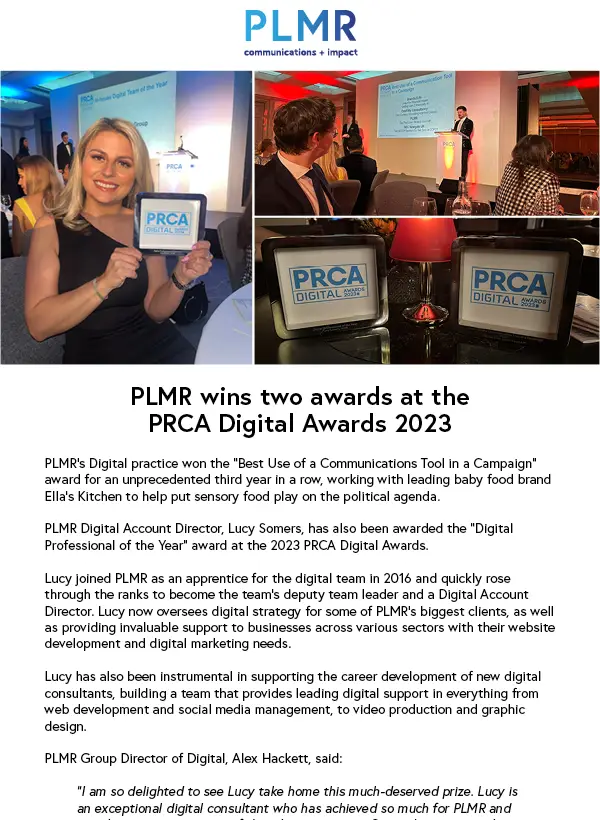I recently spoke at a LaingBuisson webinar about managing risk in the social care sector in the post-pandemic era. PLMR specialises in working with corporate care providers to help them manage their reputational risk, and throughout the pandemic we have supported many operators to navigate through the multiple communication challenges posed by a global pandemic.
As life starts to return to something resembling normality, I have five key take-aways for how care providers can continue to manage and protect their reputation, especially as the regulatory regime evolves.
1. Maintain (or start!) regular communications with families
During the pandemic, and at a time of heightened fear, many providers started regularly and proactively engaging with the families of their residents. Whether it was through a helpline, weekly bulletin, or monthly newsletter, providers were arguably more communicative with families than ever before.
With Home Managers under pressure, and as visiting resumes, there will be a temptation to return to relying on families to contact a home for information, rather than providing this proactively. This would be a mistake.
Families have come to expect regular updates on how a home is supporting their nearest and dearest. It is incredibly difficult to reduce the frequency or quality of updates without being seen as becoming ‘uncommunicative’ – a view that might lead to issues with the CQC and other regulators when they seek feedback from families.
It has become expected, even with companies I have a transactional relationship with such as McDonalds, to provide regular email updates, so therefore one would expect the same and more from a company that houses and cares for a loved one. Post pandemic, it is important to uphold the valid expectation of communication of substance in a structured and proactive way.
These updates do not need to be long or detailed– perhaps a few hundred words and some photos of home life that week – but it goes a long way to demonstrating the quality of care and the ethos of transparency and partnership that should be the hallmarks of all care providers.
2. Remember that families generate headlines
As an extension of this – and with a view to protecting your reputation in the eyes of the wider public – it is important to remember that unhappy families often generate unfavourable press headlines or spread negative messages about your service on social media.
When I’m asked to help respond to these complaints, more often than not it is clear the provider missed multiple opportunities to engage with the family and resolve their problem at an earlier stage.
Going to the press, or posting online, is often the last resort of a family exasperated at the slow, unresponsive, or uncaring communication they’ve had with a home or company about what they see as a legitimate complaint. Small issues can often snowball, compounded by what they see as not being taken seriously.
I would recommend every provider take a close look at their complaints and escalation procedures to make sure they are fit for purpose. More importantly, providers need to make sure that every colleague involved in engaging with families is familiar with the principles of good customer service. Empathy and compassion go a long way to building good will, especially if you don’t agree with the premise of the complaint.
3. Simplicity is key
Every job has its fair share of jargon, and the care sector is no different.
As far as you can, use plain English and describe things as simply as possible so the reader can understand the message. After all, there’s no point communicating if the audience don’t understand what you’re trying to tell them.
‘Infection control procedures’ might sound fancy, and is a succinct and all-encompassing phrase, but why not say ‘regular deep cleaning and disinfection’? It’s not glamourous, but it’s clear what you’re doing.
4. Remember to communicate internally
Under changes to the CQC’s regulatory landscape, intel and feedback gathered from your home teams will form part of the risk assessment process that decides whether to inspect or not. It is therefore more important than ever to make sure you engage colleagues fulsomely so that they understand what you expect of them, what regulators expect of them, how they can play a full role in delivering a high-quality care service, and to proactively gather and act on their feedback.
Often the task of speaking directly with colleagues is left to the Home Manager, with Head Office messages filtered through the prism of an Area Manager and Home Manager before reaching the front line. Instead, a more concerted, structured and planned internal communications programme should be rolled out, including providing effective ways for frontline commentary to be fed back up to senior managers.
Generally, your frontline teams are the main interface with families and visiting professionals. In many ways they are the ‘shop window’ through which external audiences receive the perceptions of local and senior management. They are the critical part of how your reputation is shaped on the ground,
5. Understand press appetite for negativity remains high
Throughout the pandemic we’ve seen an intense media focus on the number of outbreaks, cases and deaths taking place in care homes – but no attention was paid to the sacrifices carers made to keep residents engaged and supported; the number of residents that recovered due to the love and attention of dedicated carers; the bravery of carers working in a knowingly infected environment; and the undoubted mental health impact of witnessing the death of so many residents you have a close bond with.
The media has rarely been a friend to the care sector and that trend looks set to continue. But we have increasingly seen local papers highlighting Covid-19 death data when reporting on non-covid stories, and particularly when reporting regulator or Council enforcement action. This gives the horrors of the pandemic a long-tailed impact on the reputation of a service, compounding other bad news, and making it harder for a home to move on.
Therefore, providers need to ‘make hay whilst the sun shines’, making sure to promote good news stories in local media and on social media, and to build a strong, positive local reputation. It’s much easier to sustain a few press blows when the majority of the local community believe you are a genuinely caring home; it’s far harder when they have no opinion and the first thing they hear is negative.





